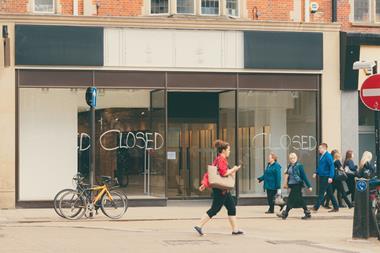New data compiled by the Local Data Company (LDC) charts both the toll the coronavirus crisis has taken on many UK retailers but also highlights the categories that are proving more resilient.
- Store closures more than double in first half of 2020 compared to first half of 2019
- Barbershops take the most physical space for the third year in a row
- Fashion and mobile phone shops the hardest hit in the first half of the year
Research by LDC has found that in the first half of 2020, 7,834 shops, pubs, restaurants and leisure sites (units) across the UK closed down. This was a 115% increase on store closures in the first half of 2019, which saw 3,647 closures.
In terms of openings, there was an uptick across the UK in the first half of 2020 at 23,305, up from 22,115 last year.

However, the data shows this uptick was not enough to outstrip the rate of high street closures, which increased by 5,377 compared to 2019 – a 21% increase in the total number of closures as businesses struggled to survive in the face of the Covid-19 pandemic.
LDC’s head of retail and strategic partnerships Lucy Stainton said these figures were just from the first few weeks of the last lockdown and predicted they would only be “compounded” by a second national lockdown.
The final figures were likely to be much worse, Stainton pointed out, highlighting that 23% of all non-essential stores that closed in the first lockdown had remained closed, even after such stores were allowed to reopen their doors from June.
The LDC data also showed that in the first half of the year, independent high street businesses and retailers proved more resilient than the national chains.
In the first half of the year, 1,833 independent occupiers closed stores, compared with 6,001 sites previously occupied by national chains.
Stainton said: “The latest figures on the GB retail and leisure market tell the story of an immensely challenging few months for the retail and hospitality sector. While the independent market has fared much better than chains, it is still in decline and combined, these two sectors total the biggest decline seen in an H1 period since our records began.
“The independent market has fared better as these businesses have been able to be more agile, bringing in new product lines and offering food deliveries, have a smaller cost base to cover during periods of little or no trade and have been able to take advantage of government support schemes.”
Top 10 growing categories
Perhaps unsurprisingly given their designation as ‘essential’ during the first lockdown in the spring, so exempt from closure, the biggest growing retail category in terms of new stores in the first half of the year was in food retailing.
| Retail category | Units net change |
|---|---|
| Barbers | 430 |
| Beauty salons | 308 |
| Nail salons | 129 |
| Fast-food takeaway | 116 |
| Pizza takeaway | 68 |
| Coffee shops | 60 |
| Travel agents | 51 |
| Restaurants and bars | 48 |
| Supermarkets | 44 |
| Grocers | 40 |
Supermarkets and grocers opened 84 new stores in the first half of the year between them, according to the LDC data.
More broadly, LDC found that convenience stores (including food retailers and off-licences) were the only high street category to see “an improvement in net decline” compared to the same period in 2019 – with a net loss of 768 in 2020 compared to 787 the previous year.
However, as LDC notes, essential retailers “faced their fair share of challenges, with stockpiling placing pressure on supply chains and an overwhelming surge in demand for delivery services”.
In terms of high street businesses more widely, the category taking the most physical space in the first half of the year was barbershops for the third year in a row.
These were followed by beauty and nail salons and then fast-food and pizza takeaways.
Occupiers dropping out of the top 20 in 2020 included pubs and bars, alternative and complementary medicine providers and mobile phone shops.
Top 10 declining categories
The data confirms that in the first half of 2020, the retail categories hardest hit by the lockdown measures were in fashion, footwear, books and homeware.
| Retail category | Units net change |
|---|---|
| Bookmakers | -867 |
| Mobile phone shops | -586 |
| Fashion | -371 |
| Estate agents | -326 |
| Electricals | -322 |
| Clothes – women | -232 |
| Newsagents | -214 |
| Chemists/toiletries | -207 |
| Recruitment agencies | -206 |
| Charity shops | -186 |
LDC said that retailers in these “comparison goods” categories accounted for 64% of all lost units during the period – a net loss of 4,975 stores across the UK.
This net closure figure was more than double the figure from the first half of 2019 and was the highest number of closures since at least 2014.
LDC said it “reflects the vast increase in online sales which had been rising since April 2017 but jumped in April as a result of lockdown”.
Figures released by the Office for National Statistics this year showed ecommerce sales across categories this year peaked at 33.4% in May, compared to a peak of 19.7% in August in 2019.
While high street retailers have been hit hard, the LDC data showed that hospitality and leisure businesses have suffered as well, losing a net 1,263 units in the period, compared to just 354 in the first half of 2019 – a 259% increase.
In terms of all occupier categories, LDC found that betting shops had been the worst affected, followed by once-ubiquitous mobile phone shops.
In terms of all categories, fashion stores were the third-worst hit and the worst of any retail category with womenswear brands, in particular, bearing the brunt of closures.
Electrical goods retailers also struggled in the first half of the year, as did chemists and charity shops.
It is worth noting that these figures were compiled before the government’s announcement last Friday that England would again be plunged into a second lockdown, with all non-essential retailers and high street businesses being forced to close for at least a month from November 5.
Stainton said the announcement would come as a “huge blow to many retailers” and would likely again have a “significant” impact on the high street.
LDC’s predictions for the second half of 2020 paint a historically grim picture. By the end of the second half of this year, Stainton predicts that over 18,000 net stores will close due to the second lockdown.
“There’s no ignoring the realities that the pandemic has accelerated the velocity of changes being seen prior,” Stainton said.
“The record number of closures show just how devastating this pandemic has already been and could continue to be on our industry given how quickly we’ve seen these closures filtering through”.


























No comments yet